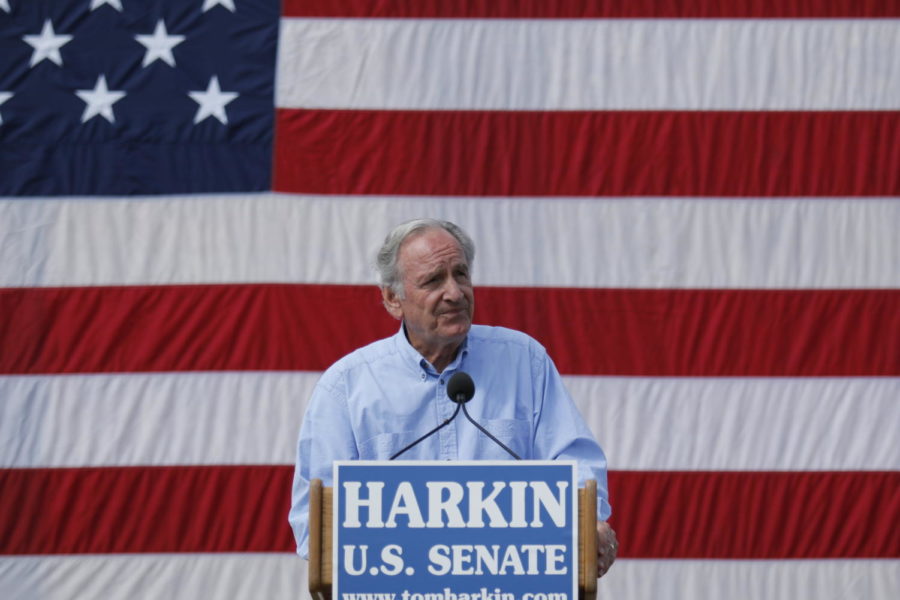Woods: High hourly wage imperils economy
Richard Martinez/Iowa State Daily
The 37th Harkin Steak Fry in Indianola, Iowa, on Sept. 14 drew in a variety of potential Iowa political candidates and special guests including former President Bill Clinton and former Secretary of State Hillary Clinton. This is the senator’s final steak fry as he ends his congressional career, vacating his Senate seat in January 2015.
September 22, 2014
In our country’s current economic state, it is impossible to live on $7.25 an hour. But raising the minimum wage to what is being proposed — $10.10 an hour — isn’t the answer that will solve all the issues Americans face financially.
Raising the minimum wage has the capabilities of causing economic turmoil and things like inflation and higher unemployment rates will occur.
Businesses big and small cannot afford to pay their employees $15 per hour. The businesses would be forced to cut back on not only employee’s hours but also how many people they have on staff. In extreme cases, machines may be used to take the place of employees requesting higher pay.
It all comes down to supply and demand. It just isn’t logical to demand what can’t be supplied. Businesses struggle as it is to make a profit with the economy in the state that it’s in. To require that they also increase wages for their employees would suffocate the possibility of making any profit whatsoever.
In a hearing on the minimum wage conducted by the Senate committee on Health, Education, Labor and Pensions, Sen. Tom Harkin, who is also the committee chairman, stated that while the overall benefits of increasing the minimum wage outweigh the costs, it is still a question for policymakers to decide.
“The Congressional Budget Office’s report did point out, however, that the benefits and costs would be different for different groups of people,” Harkin said. “Most low-wage workers would receive higher pay that would increase their family’s income, and some of those families would see their income rise above the federal poverty threshold.”
He went on to say that some jobs for low-wage workers would probably be eliminated.
“Other people would be affected differently,” Harkin said. “For example, a few higher-wage workers would owe their jobs and increased earnings to the heightened demand for goods and services that would result from a minimum wage increase. In addition, business owners would see reductions in real, inflation-adjusted income — as would consumers, who would face higher prices as a result of the minimum-wage increase.”
In an assessment done in February on the effects of a minimum wage increase on employment and family income, the Congressional Budget Office stated if the proposed $10.10 an hour minimum wage went into effect, we would see a 90 percent chance that there would be a large reduction of more than 500,000 workers in the second half of 2016, relative to what would happen under current law.
Specifically, the office estimates, “Once fully implemented in the second half of 2016, the $10.10 option would reduce total employment by about 500,000 workers, or 0.3 percent … As with any such estimates, however, the actual losses could be smaller or larger.”
There is also a second option for a minimum wage increase, a lower option that has a much more reasonable effect on the economy.
A $9.00 hourly minimum wage would only reduce employment by about 100,000 employees, or by less than 0.1 percent, the office projects. This is substantially less than the potential 500,000 employees if the wage were raised to $10.10 an hour.
“There is about a two-thirds chance that the effect would be in the range between a very slight increase in employment and a reduction in employment of 200,000 workers,” the office said about the $9.00 option.
There are findings that increasing the minimum wage reduces employment in two ways. According to conventional economic analysis, the first way is that higher wages increase the cost of producing goods and services to employers.
Inflation occurs and the employers pass on some of their increased costs to consumers in the form of higher prices. Those higher prices lead the consumers to purchase fewer products. This causes a ripple effect and the employers consequently produce fewer goods and services. Because of this they hire fewer workers.
The second way is that a minimum-wage increase raises the cost of low-wage workers relative to other inputs that employers use to produce goods and services, such as machines, technology and more productive higher-wage workers, according to conventional economic analysis.
As a result, employers respond by reducing their use of low-wage workers, substituting them for those other options.
Employers might also respond to an increase in the minimum wage in ways other than boosting prices or substituting other options for employees.
“For example, they might partly offset a minimum-wage increase by reducing other costs, including workers’ fringe benefits, such as health insurance or pensions, and job perks, such as free meals. As a result, a higher minimum wage might increase total compensation, which includes benefits and perks, less than it increased cash wages alone,” the office’s assessment stated.
So it only makes sense that raising the minimum wage to $10.10 would not only be detrimental to our economy but to large and small businesses as well. In a more perfect and reasonable world, the more applicable solution would be to lower the cost of living, but that is next to impossible.







